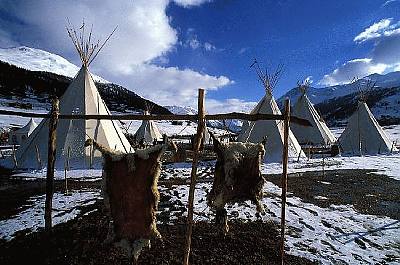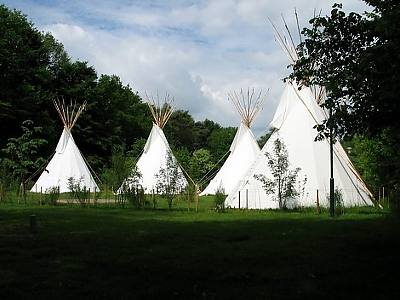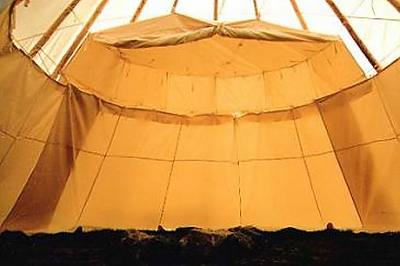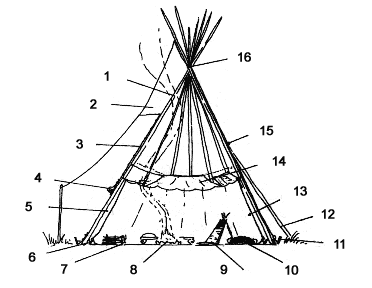About tipis
"Made for living"
 Probably everyone has seen this strange sight before - A mysterious cone with lots of thin sticks poking out the top and possibly a barely visible cloud of smoke rising to the sky.
Probably everyone has seen this strange sight before - A mysterious cone with lots of thin sticks poking out the top and possibly a barely visible cloud of smoke rising to the sky.
A tipi - the tent of the North American prairie Indians.
Only few people have seen them from the inside and only very few know and can vouch from their own experience that we're dealing with the most perfect accomodation in nature. But it is true. The tipi is always perfectly ventilated, light, cool in the summer, warm in the winter, it resists rain and storms and is comfortable and picturesque with a glowing fire inside.
 The term "tipi" originates from the language of the Dakota Indians. It is constructed of two syllables: "ti", which means "live" and "pi", which is the ending signifying a noun. Tipi thus means "home" or "residence". Tipis are often falsely called wigwams - but this is a word from eastern Indian tribes describing a dome-shaped grass hut, and has nothing to do with tepees.
The term "tipi" originates from the language of the Dakota Indians. It is constructed of two syllables: "ti", which means "live" and "pi", which is the ending signifying a noun. Tipi thus means "home" or "residence". Tipis are often falsely called wigwams - but this is a word from eastern Indian tribes describing a dome-shaped grass hut, and has nothing to do with tepees.
 The tipi is a tilted back cone with an egg shaped ground-plan. This asymetrical shape has many advantages. The steep back wall is more resistant to westerly winds, which also usually occur here. Inside, the back provides more head room and in the front part, the opening for smoke is lower above the fire. The additional smoke flaps, which give the tipi its elegant appearance, allow smoke to escape without trouble.
The tipi is a tilted back cone with an egg shaped ground-plan. This asymetrical shape has many advantages. The steep back wall is more resistant to westerly winds, which also usually occur here. Inside, the back provides more head room and in the front part, the opening for smoke is lower above the fire. The additional smoke flaps, which give the tipi its elegant appearance, allow smoke to escape without trouble.
Tipi with lining
 The thing that really differentiates a tepee from all the other smoky yurts and kahotes is the inner tent lining. This layer of tent is stretched from shoulder height to the floor and allows a chimney effect. Between the outside wall (which stands a bit above ground) and the inner wall, which goes to the floor, a draft is created which provides for perfect air circulation and doesn't allow smoke to accumulate!! In addition, the sleeping places along the edge are protected from possible dripping.
The thing that really differentiates a tepee from all the other smoky yurts and kahotes is the inner tent lining. This layer of tent is stretched from shoulder height to the floor and allows a chimney effect. Between the outside wall (which stands a bit above ground) and the inner wall, which goes to the floor, a draft is created which provides for perfect air circulation and doesn't allow smoke to accumulate!! In addition, the sleeping places along the edge are protected from possible dripping.
The creative genius of the Native American Indians is to thank for some of the popular inventions we take for granted today. Sleeping bags, snowshoes, canoes and kayaks and even the lowly moccasin. Yet of all their discoveries, it is a night in a Tipi that gives the most lasting impression of comfort and a serene harmony with nature. Picture a cool summer evening with a group of friends around a roaring campfire, a starry sky above and a pile of blankets beneath.
|
1. Smoke opening 2. Smoke flaps 3. Lacing pins 4. door rolled up 5. Entrance 6. Stakes lining 7. Wood 8. Fireplace |
 |
16. Schock 15. Tent cover 14. Ozan 13. Lining 12. Smoke flap pole 11. Stakes cover 10. Bet 9. Seat |
 The World of period
The World of period  please wait...
please wait...